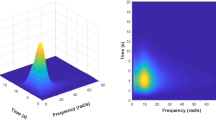Abstract
An approach for estimating ground surface rupture caused by strong earthquakes is presented in this paper, where the finite element (FE) method of continuous and discontinuous coalescent displacement fields is adopted. The onset condition of strain localization is introduced to detect the formation of the slippage line. In the analysis, the Drucker-Prager constitutive model is used for soils and the rate-and state-dependent friction law is used on the slippage line to simulate the evolution of the sliding. A simple application to evaluate the ground surface rupture induced by a reverse fault movement is provided, and the numerical simulation shows good agreement with failure characteristics observed in the field after strong earthquakes.
Similar content being viewed by others
Reference
Andrews DJ (1976), “Rupture Velocity of Plane Strain Shear Cracks,” J. Geophys. Res. 81: 5679–5687.
Belytschko T, Moes N, Usui S and Parimi C (2001), “Arbitrary Discontinuities in Finite Elements,” International Journal for Numerical Methods in Engineering, 50(4): 993–1013.
Bigoni D and T Hueckel (1991), “Uniqueness and Localization-I. Associative and Non-associative elastoplasticity,” Int. J. Solids Structures, 28(2): 197–213.
Bonilla M, Mark R and Lienkaemper J (1984), “Statistical Relations Among Earthquake Magnitude, Surface Length and Surface Fault Displacements,” Bull. Seism. Soc. Am., 74: 2379–2411.
Borja RI (2001), “Strain Localization in Frictional Materials Exhibiting Displacement Jump,” Comp. Methods. Appl. Mech. Eng. 190(20): 2555–2580.
Bray JD et al. (1994), “Analysis of Earthquake Fault Rupture Propagation Through Cohesive Soil,” J. Geotech. Eng., 120(3):562–579
Bruce ES (1995), “Frictional Weakening and Slip Complexity on Earthquake Faults,” Journal of Geophysical Research, 10:(B9) 18239–18251.
California Geological Survey (2002), Guidelines for Evaluating the Hazard of Surface Rupture, California Department of Conservation.
Chen Dasheng (1984), “Statistical Relation Between Earthquake Magnitude and Surface Rupture Length,” North China Earthquake Science, 2: 26–32. (in Chinese)
Day M (1982), “Three-dimensional Finite Difference Simulation of Fault Dynamics: Rectangular Faults with Fixed Rupture Velocity,” Bulletin of Seismological Society of America, 72: 705–727.
Dieterich (1979), “Modeling of Rock Friction-I Experimental Results and Constitutive Equations,” J Geophys Res. 84: 2161–2168.
Drucker DC (1959), “A Definiting of a Stable Inelastic Material,” J. Appl. Mech., 26: 101–106.
Eringen AC and ES Suhubi (1974), Elastodynamics I: Finite Motions, Academic Press, New York.
Guo Endong (2002), “Study on Surface Rupture Under Earthquakes,” World Information on Earthquake Engineering, 18(4):18–22. (in Chinese)
Guo Zengjian (1988), Research on Strong Earthquakes in China, China Seismological Press. (in Chinese)
Harris RA and Day SM (1999), “Dynamic 3D Simulations of Earthquakes on an Echelon Faults,” Geophys. Res. Lett. 26: 2089–2092.
Hill R (1958), “A General Theory of Uniqueness and Stability in Elatic-plastic Solids,” J. Mech. Phys. Soilds, 6(3): 236–249.
Hou Kangming (1998), “3D Numerical Simulation of Rupture: Gulang Strong Earthquake 1927,” Northwestern Seismological Journal, 20(3):59–65. (in Chinese)
Kase Y and Kuge K (1998), “Numerical Simulation of Spontaneous Rupture Processes on Two Non-coplanar Faults: the Effect of Geometry on Fault Interaction,” Geophys. J. Int., 135: 911–922.
King G and Nabelek J (1985), “Role of Fault Bends in the Initiation and Termination of Earthquake Rupture,” Science, 228: 984–987.
Lade P V and D A Cole Jr and D Cummings (1984), “Multiple Failure Surfaces Over Dip-slip Faults,” Journal of Geotechnical Engineering, ASCE, 110(5): 616–627.
Oliver J, Cervera M and Manzoli O (1999), “Strong Discontinuities and Continuum Plasticity Models: the Strong Discontinuity Approach,” International Journal of Plasticity, 15: 319–351.
Rice JR (1976), “The Localization of Plastic Deformation,” Theoretical and Applied Mechanics, North Holland Amsterdam, pp.207–220.
Rice JR (2001), “Rate and State Dependent Friction and Stability of Sliding Between Elastically Deformable Dolids,” J. of the Mechanics and Physics of Solids, 49: 1865–1898.
Scott RF (1987), “Failure. Geotechnique,” 37(4): 423–466.
Tocher D (1958), “Earthquake Energy and Ground Breakage,” Bull. Seism. Soc. Am., 48: 147–153.
Wang Haiyun (2004), “Finite Fault Source Model for Predicting Near-field Strong Ground Motion,” Doctoral Dissertation, Institute of Engineering Mechanics, China Earthquake Administration, Harbin, China.
Wells DL and Coppersmith KJ (1994), “New Empirical Relationships Among Magnitude, Rupture Length, Rupture Width, Rupture Area and Surface Displacement,” Bull. Seism. Soc. Am., 84: 974–1002.
Zhao Jisheng and Tao Xiaxin (2002), “A Constitutive Model of the Porous Media Based on Micro-mechanics Damage,” J. of Xingtian Mining Institute. 17(1): 73–78. (in Chinese)
Zhao Jisheng and Tao Xiaxin (2004), “Numerical Analysis of 2D Soil Slope Stability under Local Loading Condition,” Rock and Soil Mechanics, 25(7): 1063–1067. (in Chinese)
Zhao Jisheng and Tao Xiaxin (2005), “Onset Condition of Strain Localization in Matrix of Saturated Porous Media,” Applied Mathematics and Mechanics, 26(11): 1475–1483.
Author information
Authors and Affiliations
Corresponding author
Additional information
Supported by: National Science Foundation Council; State Key Laboratory of Frozen Soil Engineering (SKLFSE200504); State Commonweal Research Project (2002DIB30076)
Rights and permissions
About this article
Cite this article
Zhao, J., Tao, X., Shi, L. et al. An approach to evaluate ground surface rupture caused by reverse fault movement. Earthq. Engin. Engin. Vib. 5, 29–39 (2006). https://doi.org/10.1007/s11803-006-0484-6
Received:
Accepted:
Issue Date:
DOI: https://doi.org/10.1007/s11803-006-0484-6




